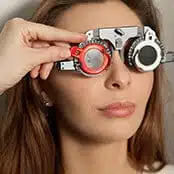
Glaucoma is a common eye condition and a leading cause of sight loss for people over age 60. It occurs when the optic nerve, which connects the eye to the brain, becomes damaged due to internal eye pressure. The pressure is often caused by a buildup of fluid in the front part of the eye. Fluid usually drains through the area where the cornea meets the iris, but pressure can build if there is any problem with normal drainage.
The optic nerve is vital for vision. It is made up of numerous nerve fibers that transmit visual information from the retina (located at the back of the inside of the eye) to the brain. Glaucoma causes these nerve fibers to gradually deteriorate, which over time can cause progressive vision loss and blindness.
Although glaucoma can occur at any age, it is more common in older adults. It can run in families, and other medical conditions such as diabetes can increase your risk of developing the condition.
Glaucoma rarely causes symptoms to start with, but it can lead to vision loss if it is not diagnosed and treated early. Vision loss due to glaucoma cannot be recovered, which makes regular eye examinations essential in diagnosing and treating the condition in its earliest stages.
Types of Glaucoma
There is more than one type of glaucoma. The most common type is called open-angle glaucoma, which develops gradually over many years. It occurs when the drainage canals in the anterior chamber (front part of the eye between the cornea and the iris) gradually become narrow or clogged. This causes a buildup of fluid and pressure within the eye.
Closed-angle glaucoma is a far less common type of glaucoma. It results when the drainage canals of the anterior chamber suddenly become blocked or covered. This causes a rapid rise in eye pressure as fluid production continues without the ability to drain. This type of glaucoma is a medical emergency.
Childhood glaucoma (congenital glaucoma) is a rare type of glaucoma that occurs in very young children as a result of an abnormality of the eye.
Diagnosis and Treatment for Glaucoma
Early detection and treatment of glaucoma is vital and should be part of your regular comprehensive eye exam. Several tests are performed to assess for glaucoma, which can include:
- A tonometer test to measure the pressure in your eye
- A dilated eye examination to assess for optic nerve damage
- A visual field test to assess your visual field and to map any areas of vision loss
- A gonioscopy to inspect the drainage angle
- A pachymetry to measure corneal thickness
The goal of treatment is to prevent and stop the progression of vision loss. If glaucoma is recognized early, sight loss can often be slowed or even prevented.
People with glaucoma generally require lifelong treatment and monitoring. Usually, eye drops are a successful treatment to control eye pressure, but surgery may be necessary if eye drops fail to reduce intraocular pressure. Selective laser trabeculoplasty (SLT) is a revolutionary FDA-approved procedure that is designed to open the drainage canals in the eyes in patients with open-angle glaucoma.
Comprehensive Eye Care in St. Louis, MO
Regular eye exams are important to monitor your eye health and prevent vision loss. Here at Advanced Sight Center, our board-certified ophthalmologists offer comprehensive eye care to keep your vision healthy. We use innovative diagnostic examinations to pinpoint eye diseases at their earliest stages, when treatment is most effective.
For more information or to schedule an appointment, contact us today at our Washington office at (636) 239-1650. You can also request an appointment now via our online form. We look forward to seeing you here!




